Identification and Optimization Strategy for the Ecological Security Pattern in Henan Province Based on Matching the Supply and Demand of Ecosystem Services
Abstract
:1. Introduction
2. Materials and Methods
2.1. Study Area
2.2. Data Sources
2.3. Ecosystem Services Supply Measurement
2.3.1. Water Supply Capacity
2.3.2. Carbon Fixation and Oxygen Release
2.3.3. Habitat Quality
2.4. Ecosystem Service Demand Estimation
2.4.1. Degree of Land Use Development
2.4.2. Population Density
2.4.3. GDP Per Land
2.5. Construction of Ecological Security Pattern Based on Supply and Demand Perspective
2.5.1. Ecological Source Site Identification
2.5.2. Resistance Surface Construction
2.5.3. Ecological Corridor Extraction
3. Results
3.1. Ecosystem Service Supply
3.2. Ecosystem Service Needs
3.3. Important Ecological Source Sites
3.4. Ecological Resistance Surface Construction and Ecological Corridor Extraction
3.4.1. Ecological Resistance Surface
3.4.2. Ecological Corridors
3.5. Construction of Ecological Security Pattern
- (1)
- The ecological conservation belt of the Yellow River Basin: The Yellow River enters Henan Province in Lingbao City and flows through eight provincial cities including Sanmenxia, Jiyuan, Luoyang, Zhengzhou, Jiaozuo, Xinxiang, Kaifeng, and Puyang, primarily along the northern regions of Sanmenxia City and the northern regions of Kaifeng City, and flows into Shandong Province in the east of Taifeng County in Puyang City, as well as the northern regions of the Yiluo River Basin that flow into the Yellow River through Luoyang City and Gongyi City on the south side of the Yellow River. The region is an important ecological barrier in the North China Plain and a high-density development zone for the economy of Henan Province.
- (2)
- The ecological protection belt of the Central Route of the South–North Water Diversion Project has a large population and frequent human activities. This region has a high demand for ecosystem services and also functions as a boundary between Henan Province’s important ecological source areas and major demand areas. Measures to preserve the ecosystem should include reducing unreasonable economic activities, improving the existing “Regulations for the Protection of Drinking Water Sources in the South-to-North Water Transfer Project in Henan Province,” strengthening water conservation forest construction in drinking water source protection areas of the South-to-North Water Transfer Project, and coordinating soil and water loss control efforts.
- (1)
- Ecological Supply Zone for Carbon Sequestration and Oxygen Release in Western Henan: This region is a clearly defined biodiversity and gene pool for various rare animals, with a total area of 25,838.5 km2 and a population of 14.6595 million. The area is mainly covered by large areas of forest, with a high forest coverage rate and abundant rare fauna and flora resources. It plays a very important role in maintaining biodiversity and is a typical high-supply, low-demand area in terms of ecosystem services. The region must prioritize the ecological environment and strengthen the protection of natural and public forests through prohibiting non-conservationist logging. The region should promote afforestation, focusing particularly on creating forests that conserve soil and water. It should also promote vegetation recovery and reconstruction while enhancing the protection of wild animals and plants through outlawing overhunting and overharvesting. Efforts should be made to maintain and restore a balance in wild animal and plant species and populations and to create a benign cycle and sustainable utilization of wild animal and plant resources.
- (2)
- Ecological Demand Zone for Population and Industry in Eastern Henan: This region covers a total area of approximately 40,981 km2 and is characterized by a high population density, accounting for about 40.44% of the total population in the study area. The proportion of cultivated land is the largest, followed by construction land, and the demand for ecosystem services is mainly high. In terms of the supply of ecosystem services, only a small amount is provided in the Laoshan District of Zhumadian. The region should strengthen farmland protection through strict control of development intensity, enhanced treatment of nonpoint source pollution, the establishment of a national core area for grain production, improved agricultural production capacity, and the vigorous development of modern agriculture. The region should also develop characteristic industries that are based on local conditions to increase farmer income, ensure a reasonable layout, optimize development, promote intensification and agglomeration, and encourage industry to support agriculture and cities to lead the rural areas. Accelerate new countryside construction through guiding the gradual and orderly transfer of rural populations. On the basis of existing urban layouts, further intensify and concentrate development, with a particular focus on planning and building central towns with strong carrying capacities for resource and environmental sustainability and improving their comprehensive service capabilities.
- (3)
- Ecological Zone for Water Supply and Recharge in Southern Henan: This region covers an area of approximately 18,910 km2 and is mainly located in the Dabie Mountain ecological functional area and the important water supply recharge area of the middle and lower reaches of the Huai River. The region is characterized by a high degree of soil erosion and sensitivity and is currently facing degradation of mountain ecosystems and accelerated soil erosion, increasing the probability of floods in the middle and lower reaches of the river. Soil and water conservation efforts need to be strengthened, and forest water conservation capacity needs to be improved while protecting biodiversity. Measures should be taken to implement ecological migration, reduce population density, and restore vegetation. The soil and water conservation policy should adhere to the principle of “combining prevention and control with prioritizing protection”.
- (1)
- Taihang Mountain Ecological Barrier: This area covers an area of approximately 766 km2. The Taihang Mountain Nature Reserve is mainly located in four counties and cities in the north of Henan Province, including Jiyuan, Qinyang, Xiuwu, and Huixian. The Taihang Mountain region is an important ecological security barrier for the North China Plain and even the central regions of China. The central route of the South-to-North Water Transfer Project runs through the region, which has 19 national-level protected areas. Through the restoration projects of mountains, rivers, forests, fields, lakes, and grasses, the damaged ecosystem has been greatly restored, and ecosystem service functions have been effectively improved. This has protected the living environment of rare animals and plants, significantly increased the value of regional ecological products, and continuously consolidated the Taihang Mountain Ecological Barrier. This has effectively ensured the ecological security, water security, and food security of the North China Plain.
4. Discussion
4.1. Ecosystem Service Selection
4.2. Scale of Ecological Security Pattern Construction
4.3. Policy Recommendations for Ecological Security Construction in Henan Province
- (1)
- Improving the ecological monitoring and evaluation system.
- (2)
- Advancing the regulation of ecological protection redlines.
- (3)
- Enhancing the quality and stability of the ecosystem.
- (4)
- Strengthening the protection of biodiversity.
4.4. Findings and Prospects of the Research
5. Conclusions
- (1)
- The total area of ecological source areas in Henan Province is 3.02 × 104 km2, accounting for 18.12% of the total study area, and is mainly concentrated in the eastern mountainous areas and southern regions of Henan. Forests account for approximately 76.2% of ecological source areas.
- (2)
- The total area of high-demand areas for ecosystem services is 4.1 × 104 km2, accounting for 24.73% of the total study area. These high-demand areas are mainly concentrated in the central and eastern regions of Henan where supply and demand for ecosystem services do not match well. The high-service areas and high-demand areas are obviously separated by the middle route of the South-to-North Water Transfer Project.
- (3)
- There are a total of 13 inter-source ecological corridors in Henan Province, with a total length of 1062.3 km. They form two main corridor axes, northeast-southwest and northwest-southeast. There are 15 ecological corridors for demand, with a total length of 1159 km. Based on the analysis of the ecosystem security pattern from the perspective of supply–demand matching in the study area, an optimization proposal of “two belts, three zones, and one barrier” is proposed for the ecosystem pattern.
Author Contributions
Funding
Data Availability Statement
Conflicts of Interest
References
- Song, L.; Zhang, L.; Yang, J.; Hou, G.; Wang, G. Influence of COVID-19 Epidemic on China’s Grain Industry. J. Agric. Sci. Technol. 2020, 22, 12–16. [Google Scholar] [CrossRef]
- Yao, P.; Fan, H.; Wu, Q.; Ouyang, J.; Li, K. Compound impact of COVID-19, economy and climate on the spatial distribution of global agriculture and food security. Sci. Total Environ. 2023, 880, 163105. [Google Scholar] [CrossRef] [PubMed]
- Karnik, H.; Peterson, H.H. Food security among low-income immigrant households and the role of social capital: A case study of Somali-American households in the Midwestern United States. Food Policy 2023, 117, 102456. [Google Scholar] [CrossRef]
- Su, F.; Liu, Y.; Chen, S.; Fahad, S. Towards the impact of economic policy uncertainty on food security: Introducing a comprehensive heterogeneous framework for assessment. J. Clean. Prod. 2023, 386, 135792. [Google Scholar] [CrossRef]
- Fei, L.; Shuang, M.; Xiaolin, L. Changing multi-scale spatiotemporal patterns in food security risk in China. J. Clean. Prod. 2023, 384, 135618. [Google Scholar] [CrossRef]
- Zhu, Y.; Wang, Z.; Luo, J.; Cui, J. Coupling and coordinated development of new urbanization and food security in main agricultural production regions in central China: A case study of Henan Province. Sci. Geogr. Sin. 2021, 41, 1947–1958. [Google Scholar] [CrossRef]
- Yu, Z.; Deng, X. Assessment of land degradation in the North China Plain driven by food security goals. Ecol. Eng. 2022, 183, 106766. [Google Scholar] [CrossRef]
- Liu, F.; Xiao, X.; Qin, Y.; Yan, H.; Huang, J.; Wu, X.; Zhang, Y.; Zou, Z.; Doughty, R.B. Large spatial variation and stagnation of cropland gross primary production increases the challenges of sustainable grain production and food security in China. Sci. Total Environ. 2022, 811, 151408. [Google Scholar] [CrossRef] [PubMed]
- Zeng, W.; Tang, H.; Liang, X.; Hu, Z.; Yang, Z.; Guan, Q. Using ecological security pattern to identify priority protected areas: A case study in the Wuhan Metropolitan Area, China. Ecol. Indic. 2023, 148, 110121. [Google Scholar] [CrossRef]
- Chen, D.; Guo, K.; Zeng, W.; Wang, F.; Li, L.; Jin, X. Study on the spatial–temporal patterns and evolution characteristics of ecological security based on dynamic evaluation in the Three Gorges Reservoir Area. Ecol. Indic. 2023, 151, 110297. [Google Scholar] [CrossRef]
- Nie, W.; Xu, B.; Yang, F.; Shi, Y.; Liu, B.; Wu, R.; Lin, W.; Pei, H.; Bao, Z. Simulating future land use by coupling ecological security patterns and multiple scenarios. Sci. Total Environ. 2023, 859, 160262. [Google Scholar] [CrossRef] [PubMed]
- Li, L.; Huang, X.; Wu, D.; Wang, Z.; Yang, H. Optimization of ecological security patterns considering both natural and social disturbances in China’s largest urban agglomeration. Ecol. Eng. 2022, 180, 106647. [Google Scholar] [CrossRef]
- Jia, Q.; Jiao, L.; Lian, X.; Wang, W. Linking supply-demand balance of ecosystem services to identify ecological security patterns in urban agglomerations. Sustain. Cities Soc. 2023, 92, 104497. [Google Scholar] [CrossRef]
- Wei, L.; Zhou, L.; Sun, D.; Yuan, B.; Hu, F. Evaluating the impact of urban expansion on the habitat quality and constructing ecological security patterns: A case study of Jiziwan in the Yellow River Basin, China. Ecol. Indic. 2022, 145, 109544. [Google Scholar] [CrossRef]
- Li, L.; Huang, X.; Wu, D.; Yang, H. Construction of ecological security pattern adapting to future land use change in Pearl River Delta, China. Appl. Geogr. 2023, 154, 102946. [Google Scholar] [CrossRef]
- Li, C.; Wu, Y.; Gao, B.; Zheng, K.; Wu, Y.; Wang, M. Construction of ecological security pattern of national ecological barriers for ecosystem health maintenance. Ecol. Indic. 2023, 146, 109801. [Google Scholar] [CrossRef]
- Pan, N.; Du, Q.; Guan, Q.; Tan, Z.; Sun, Y.; Wang, Q. Ecological security assessment and pattern construction in arid and semi-arid areas: A case study of the Hexi Region, NW China. Ecol. Indic. 2022, 138, 108797. [Google Scholar] [CrossRef]
- Zhai, T.; Wang, J.; Jin, Z.; Qi, Y.; Fang, Y.; Liu, J. Did improvements of ecosystem services supply-demand imbalance change environmental spatial injustices? Ecol. Indic. 2020, 111, 106068. [Google Scholar] [CrossRef]
- Wu, X.; Liu, S.; Zhao, S.; Hou, X.; Xu, J.; Dong, S.; Liu, G. Quantification and driving force analysis of ecosystem services supply, demand and balance in China. Sci. Total Environ. 2019, 652, 1375–1386. [Google Scholar] [CrossRef]
- Xu, Q.; Yang, R.; Zhuang, D.; Lu, Z. Spatial gradient differences of ecosystem services supply and demand in the Pearl River Delta region. J. Clean. Prod. 2021, 279, 123849. [Google Scholar] [CrossRef]
- Wei, W.; Nan, S.; Xie, B.; Liu, C.; Zhou, J.; Liu, C. The spatial-temporal changes of supply-demand of ecosystem services and ecological compensation: A case study of Hexi Corridor, Northwest China. Ecol. Eng. 2023, 187, 106861. [Google Scholar] [CrossRef]
- Ala-Hulkko, T.; Kotavaara, O.; Alahuhta, J.; Hjort, J. Mapping supply and demand of a provisioning ecosystem service across Europe. Ecol. Indic. 2019, 103, 520–529. [Google Scholar] [CrossRef]
- Liu, L.; Liu, C.; Wang, C.; Li, P. Supply and demand matching of ecosystem services in loess hilly region: A case study of Lanzhou. Acta Geogr. Sin. 2019, 74, 1921–1937. [Google Scholar]
- Talukdar, S.; Singha, P.; Shahfahad; Mahato, S.; Praveen, B.; Rahman, A. Dynamics of ecosystem services (ESs) in response to land use land cover (LU/LC) changes in the lower Gangetic plain of India. Ecol. Indic. 2020, 112, 106121. [Google Scholar] [CrossRef]
- Meng, S.; Huang, Q.; Zhang, L.; He, C.; Inostroza, L.; Bai, Y.; Yin, D. Matches and mismatches between the supply of and demand for cultural ecosystem services in rapidly urbanizing watersheds: A case study in the Guanting Reservoir basin, China. Ecosyst. Serv. 2020, 45, 101156. [Google Scholar] [CrossRef]
- Zhao, X.; Ma, P.; Li, W.; Du, Y. Spatiotemporal changes of supply and demand relationships of ecosystem services in the Loess Plateau. Acta Ecol. Sin. 2021, 76, 2780–2796. [Google Scholar]
- Vrebos, D.; Staes, J.; Vandenbroucke, T.; Haeyer, T.D.; Johnston, R.; Muhumuza, M.; Kasabeke, C.; Meire, P. Mapping ecosystem service flows with land cover scoring maps for data-scarce regions. Ecosyst. Serv. 2015, 13, 28–40. [Google Scholar] [CrossRef]
- Zhang, D.; Qu, L.; Zhang, J. Ecological security pattern construction method based on the perspective of ecological supply and demand: A case study of Yangtze River Delta. Acta Ecol. Sin. 2019, 39, 7525–7537. [Google Scholar]
- Xie, G.; Zhang, C.; Zhang, L.; Chen, W.; Li, S. Improvement of the Evaluation Method for Ecosystem Service Value Based on Per Unit Area. J. Nat. Resour. 2015, 30, 1243–1254. [Google Scholar]
- Wu, P.; Lin, H.; Tian, L. Construction of ecological security pattern based on: A case study in Xiongan New Area, Hebei Province, China. J. Saf. Sci. Technol. 2018, 14, 5–11. [Google Scholar]
- Dai, Y.; Li, J.; Yang, J. Spatiotemporal responses of habitat quality to urban sprawl in the Changsha metropolitan area. Prog. Geogr. 2018, 37, 1340–1351. [Google Scholar]
- Pan, J.; Li, Z. Analysis on trade-offs and synergies of ecosystem services in arid inland river basin. Trans. Chin. Soc. Agric. Eng. 2017, 33, 280–289. [Google Scholar]
- Zheng, Y.; Han, J.; Huang, Y.; Fassnacht, S.R.; Shuai, X.; Lv, E.; Min, C. Vegetation response to climate conditions based on NDVI simulations using stepwise cluster analysis for the Three-River Headwaters region of China. Ecol. Indic. 2017, 92, 18–29. [Google Scholar] [CrossRef]
- Villamagna, A.M.; Angermeier, P.L.; Bennett, E.M. Capacity, pressure, demand, and flow: A conceptual framework for analyzing ecosystem service provision and delivery. Ecol. Complex. 2013, 15, 114–121. [Google Scholar] [CrossRef]
- Peng, J.; Li, H.; LIiu, Y.; Hu, Y.; Yang, Y. Identification and optimization of ecological security pattern in Xiong’an New Area. Acta Geogr. Sin. 2018, 73, 701–710. [Google Scholar]
- Peng, J.; Guo, X.; Hu, Y.; Liu, Y. Constructing ecological security patterns in mountain areas based on geological disaster sensitivity: A case study in Yuxi City, Yunnan Province, China. Chin. J. Appl. Ecol. 2017, 28, 627–635. [Google Scholar] [CrossRef]
- Knaapen, J.P.; Scheffer, M.; Harms, B. Estimating habitat isolation in landscape planning. Landsc. Urban Plan. 1992, 23, 1–16. [Google Scholar] [CrossRef]
- Hu, Q.; Chen, S. Optimizing the ecological networks based on the supply and demand of ecosystem services in Xiamen-Zhangzhou-Quanzhou region. J. Nat. Resour. 2021, 36, 342–355. [Google Scholar] [CrossRef]
- Rong, Y.; Yan, Y.; Wang, C.; Zhang, W.; Zhu, J.; Lu, H.; Zheng, T. Construction and optimization of ecological network in Xiong’an New Area based on the supply and demand of ecosystem services. Acta Ecol. Sin. 2020, 40, 7197–7206. [Google Scholar]
- Lv, C.M.; Liao, H.L.; Ling, M.H.; Wu, Z.N.; Yan, D.H. Assessment of eco-economic effects of urban water system connectivity project. Environ. Sci. Pollut. R. 2022, 29, 53353–53363. [Google Scholar] [CrossRef]
- Zhao, W.; Liu, Y.; Daryanto, S.; Fu, B.; Wang, S.; Liu, Y. Metacoupling supply and demand for soil conservation service. Curr. Opin. Env. Sust. 2018, 33, 136–141. [Google Scholar] [CrossRef]
- Yu, G.; Yang, M.; Chen, Z.; Zhang, L. Technical approach and strategic plan for large-scale ecological and environmental governance and national ecological security pattern construction. Chin. J. Appl. Ecol. 2021, 32, 1141–1153. [Google Scholar] [CrossRef]
- Peng, J.; Zhao, H.; Liu, Y.; Wu, J. Research progress and prospect on regional ecological security pattern construction. Geogr. Res. 2017, 36, 407–419. [Google Scholar]
- Ma, L.; Liu, H.; Peng, J.; Wu, J. A review of ecosystem services supply and demand. Acta Geogr. Sin. 2017, 72, 1277–1289. [Google Scholar]
- Jing, Y.; Chen, L.; Sun, R. A theoretical research framework for ecological security pattern construction based on ecosystem services supply and demand. Acta Ecol. Sin. 2018, 38, 4121–4131. [Google Scholar]
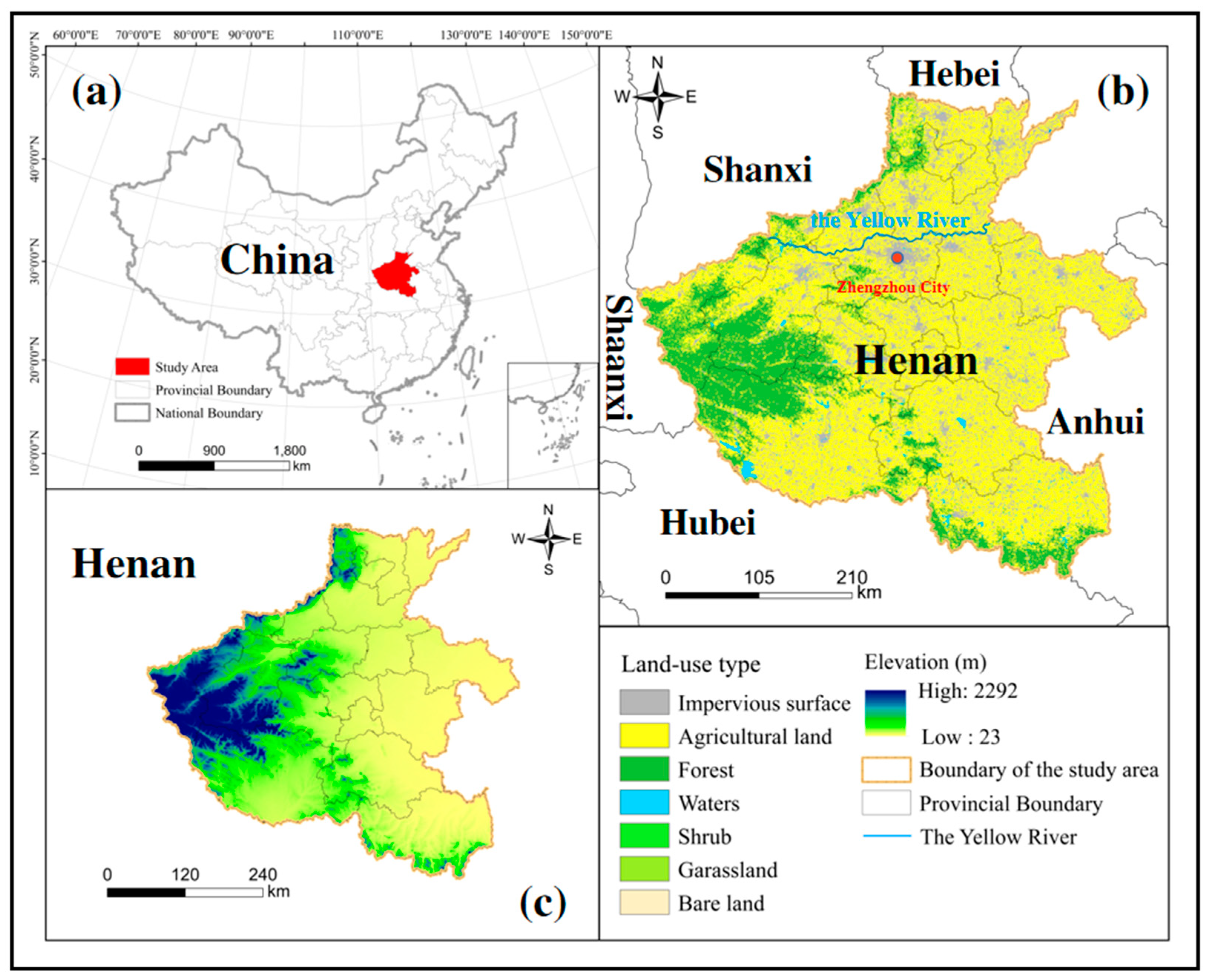
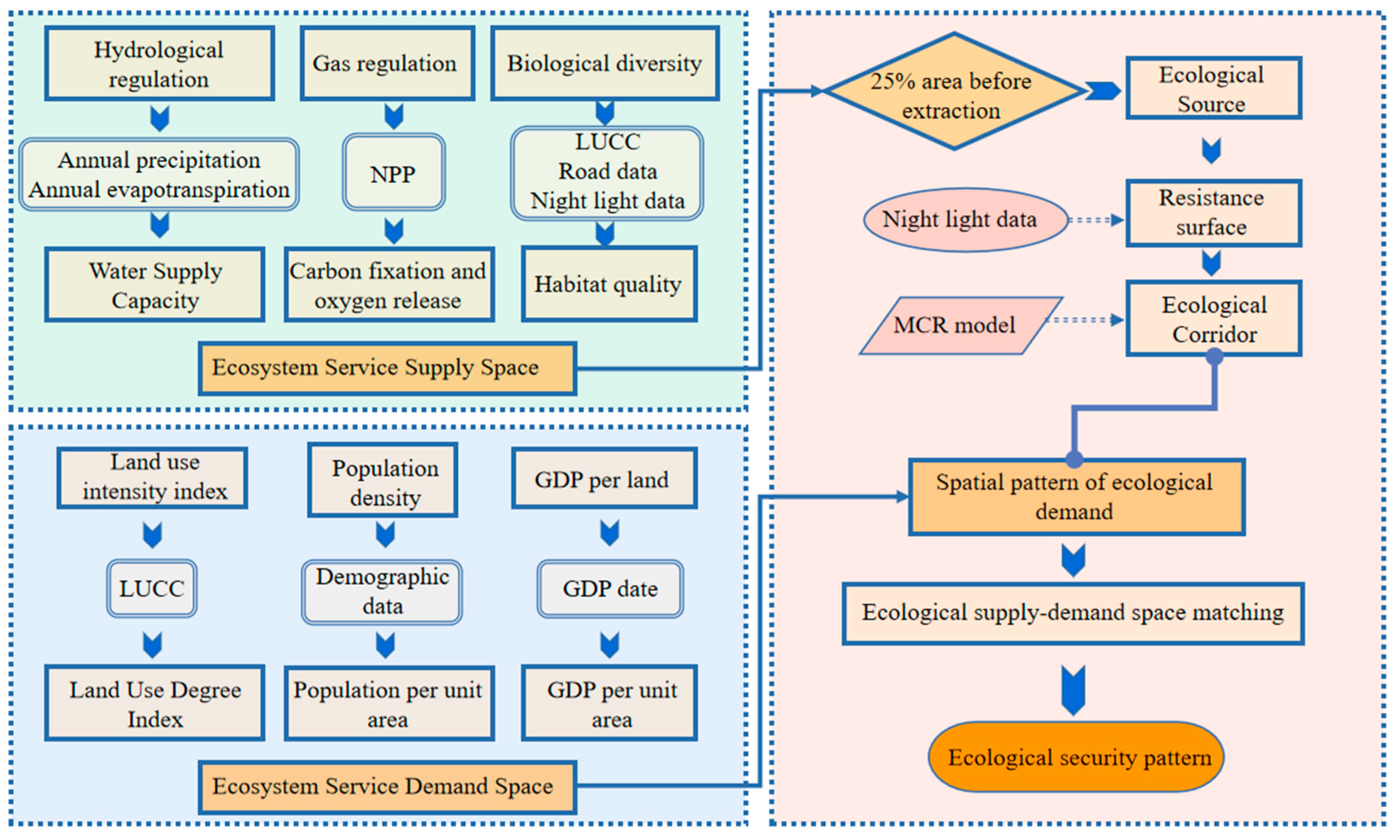

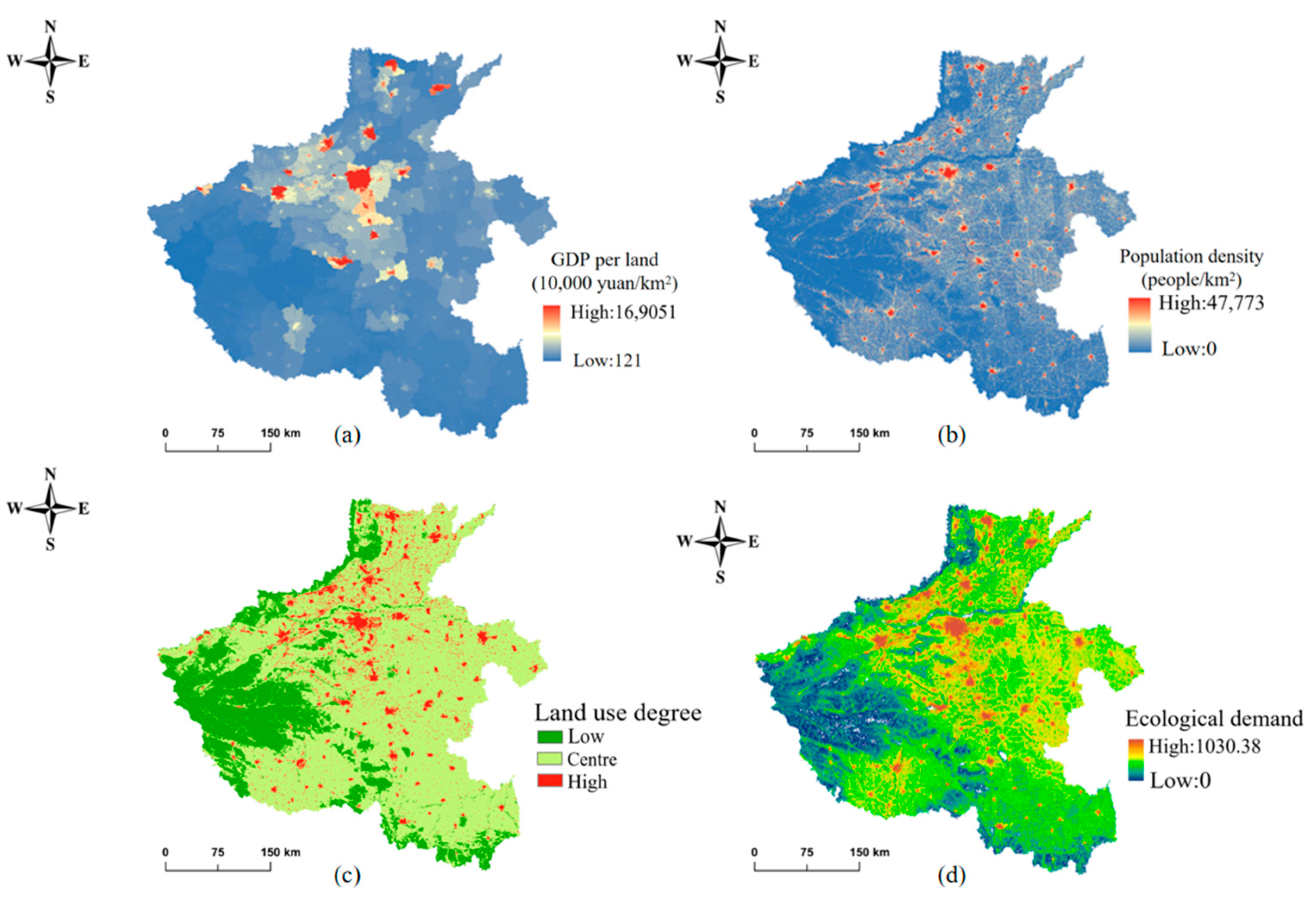
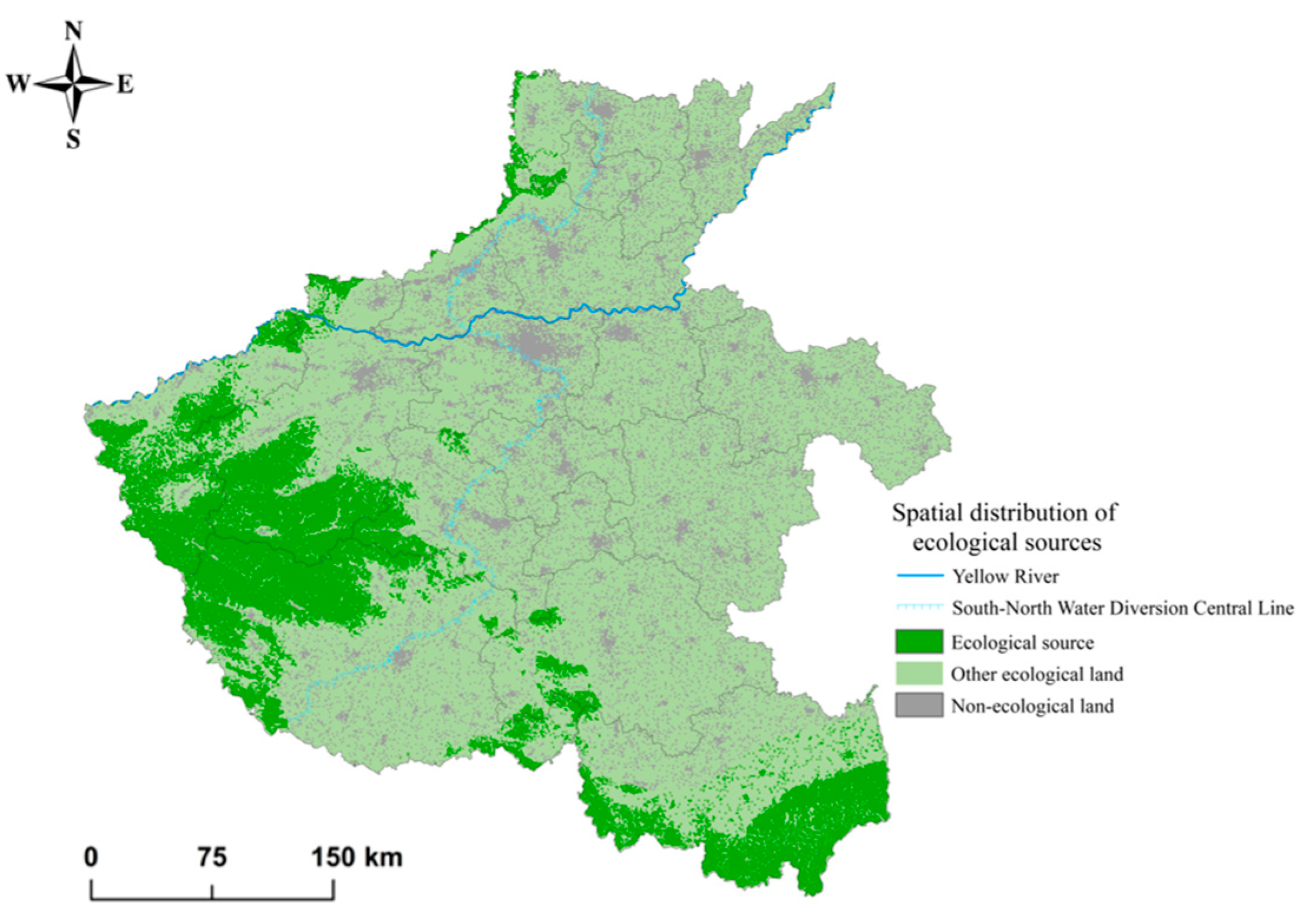
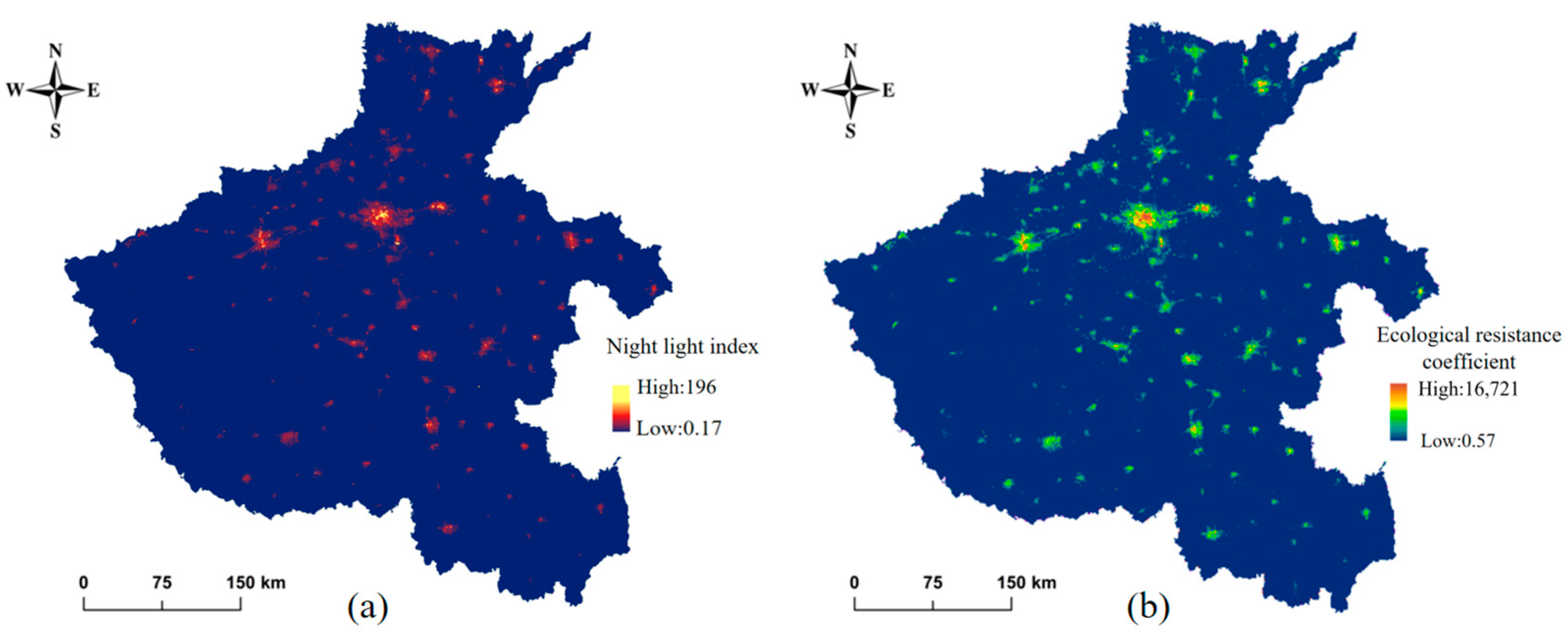
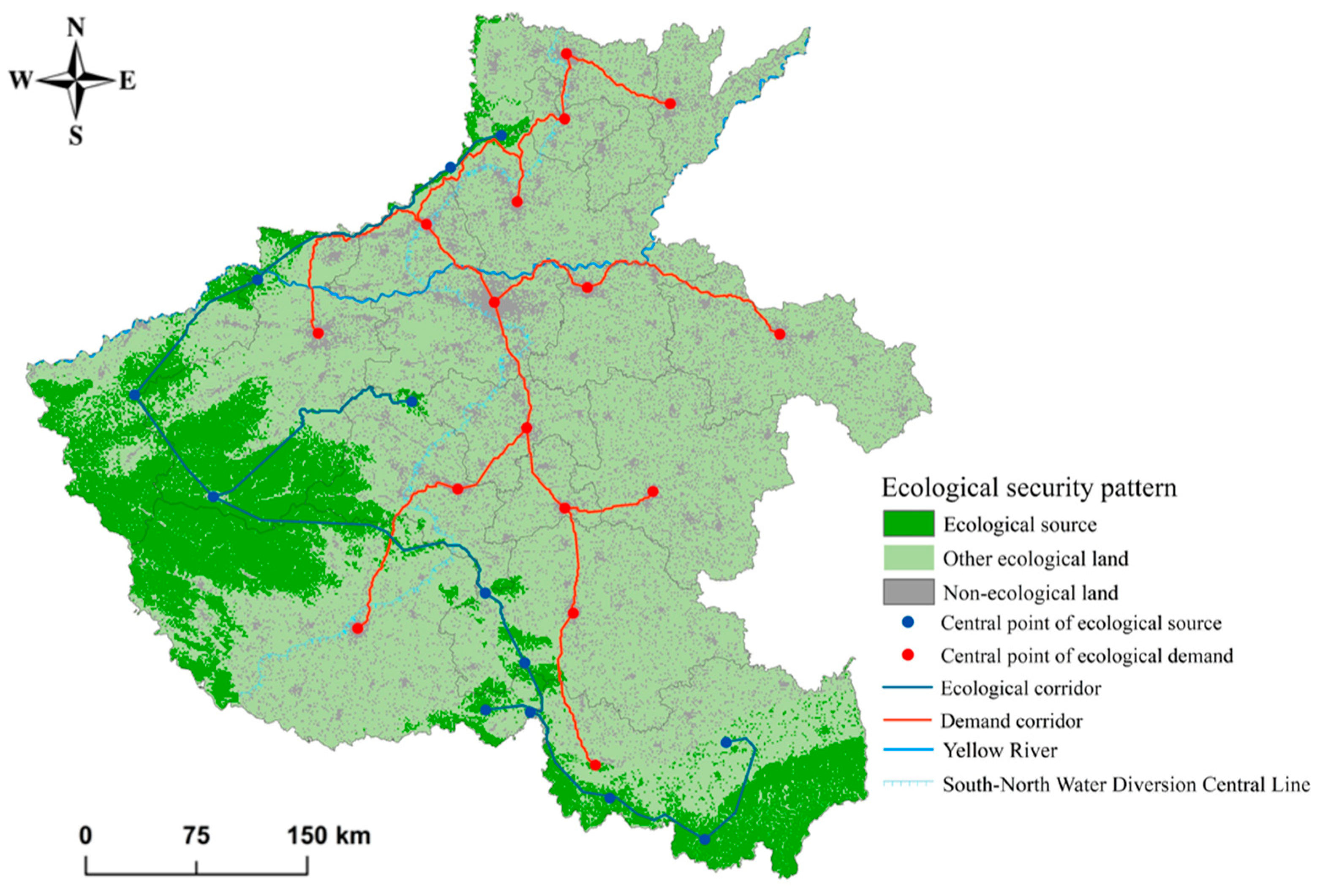
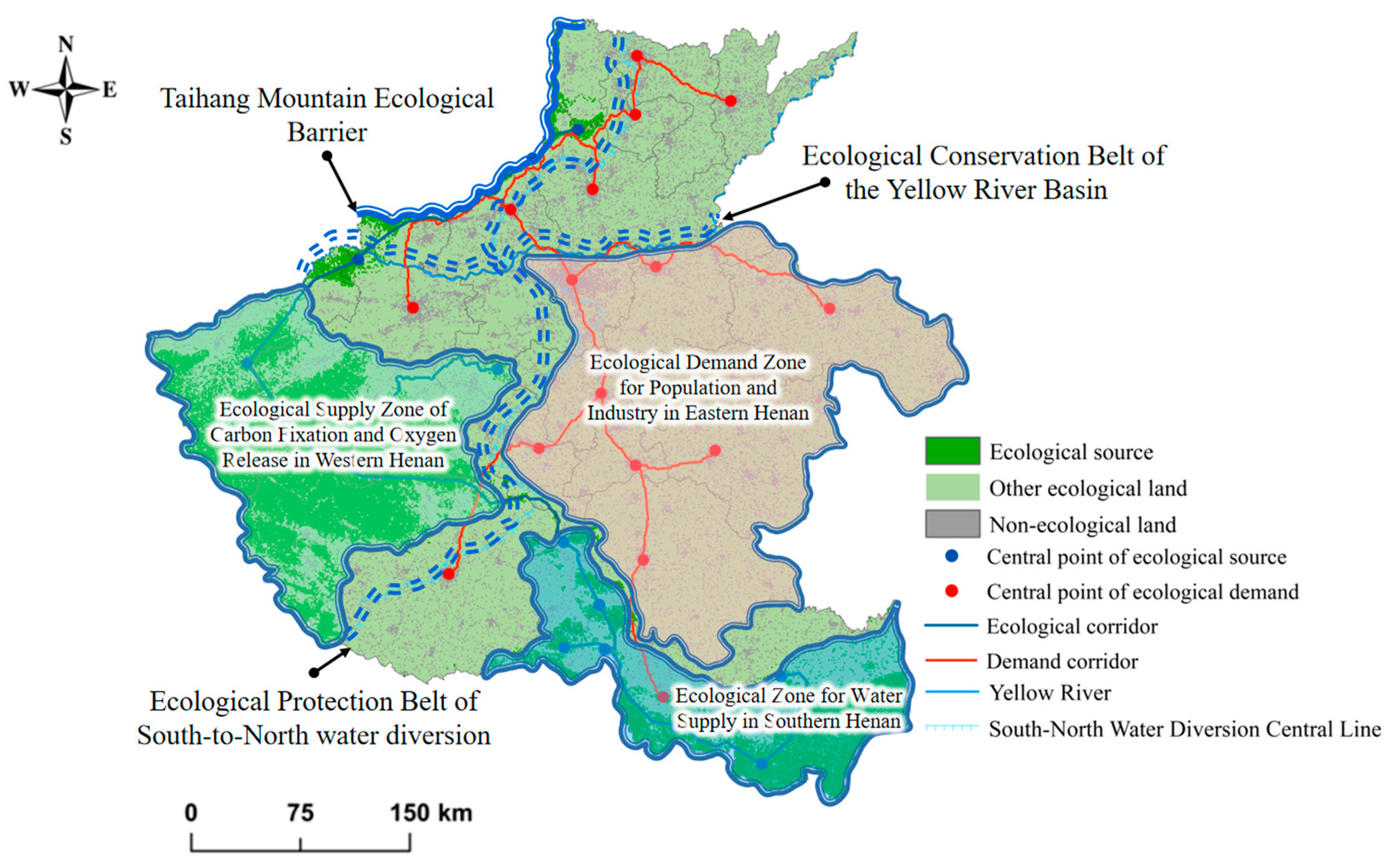
| Data Type | Data Sources | Spatial Scale |
|---|---|---|
| Land use data | The 30 m annual land cover datasets and its dynamics in China from 1990 to 2020 (https://zenodo.org/record/5210928#.YcZ_nWBByUk, accessed on 5 November 2022.) | 30 m |
| Digital Elevation Model (DEM) | Geospatial Data Cloud (http://www.gscloud.cn/ accessed on 15 January 2023.) | 30 m |
| Normalized Vegetation Index (NDVI) | MODIS Data Products:MOD13Q1, NASA (https://ladsweb.modaps.eosdis.nasa.gov/ accessed on 5 February 2023.) | 250 m |
| Net primary productivity (NPP) | MODIS Data Products:MOD17A3HGF Version 6.0 (https://lpdaac.usgs.gov/ accessed on 10 February 2023.) | 1 km |
| Evapotranspiration data | Meteorological Data Sharing Network (http://data.cma.cn/ accessed on10 February 2023.) | 500 m |
| Night light data | NOAA Nightlight Data Center (https://ngdc.noaa.gov/eog/download.html, accessed on 15 February 2023.) | 500 m |
| Population density | Resources and Environment Science and Data Center (http://www.resdc.cn/data.aspx, accessed on 17 February 2023.) | 1 km |
| GDP per land | Resources and Environment Science and Data Center (http://www.resdc.cn/data.aspx, accessed on 17 February 2023.) | 1 km |
| Threat Source | Weights | Sensitivity | Maximum Influence Distance/km | |||
|---|---|---|---|---|---|---|
| Farmland | Woodland | Grassland | Water | |||
| Highway | 1 | 0.5 | 0.55 | 0.2 | 0.55 | 6 |
| Railway | 0.9 | 0.8 | 0.65 | 0.3 | 0.65 | 3 |
| Construction | 1 | 0.5 | 1 | 0.75 | 0.9 | 8 |
| Night lights | 1 | 0.75 | 0.75 | 0.5 | 0.8 | 10 |
| Land Use Type | Resistance Value | Land Use Type | Resistance Value |
|---|---|---|---|
| Cropland | 100 | Water body | 100 |
| Forest land | 1 | Barren | 300 |
| Shrub | 10 | Impervious | 500 |
| Grassland | 10 |
Disclaimer/Publisher’s Note: The statements, opinions and data contained in all publications are solely those of the individual author(s) and contributor(s) and not of MDPI and/or the editor(s). MDPI and/or the editor(s) disclaim responsibility for any injury to people or property resulting from any ideas, methods, instructions or products referred to in the content. |
© 2023 by the authors. Licensee MDPI, Basel, Switzerland. This article is an open access article distributed under the terms and conditions of the Creative Commons Attribution (CC BY) license (https://creativecommons.org/licenses/by/4.0/).
Share and Cite
Chen, S.; Li, L.; Li, X.; Li, D.; Wu, Y.; Ji, Z. Identification and Optimization Strategy for the Ecological Security Pattern in Henan Province Based on Matching the Supply and Demand of Ecosystem Services. Land 2023, 12, 1307. https://doi.org/10.3390/land12071307
Chen S, Li L, Li X, Li D, Wu Y, Ji Z. Identification and Optimization Strategy for the Ecological Security Pattern in Henan Province Based on Matching the Supply and Demand of Ecosystem Services. Land. 2023; 12(7):1307. https://doi.org/10.3390/land12071307
Chicago/Turabian StyleChen, Shuaiqi, Ling Li, Xingming Li, Donghao Li, Yong Wu, and Zhengxin Ji. 2023. "Identification and Optimization Strategy for the Ecological Security Pattern in Henan Province Based on Matching the Supply and Demand of Ecosystem Services" Land 12, no. 7: 1307. https://doi.org/10.3390/land12071307
APA StyleChen, S., Li, L., Li, X., Li, D., Wu, Y., & Ji, Z. (2023). Identification and Optimization Strategy for the Ecological Security Pattern in Henan Province Based on Matching the Supply and Demand of Ecosystem Services. Land, 12(7), 1307. https://doi.org/10.3390/land12071307






